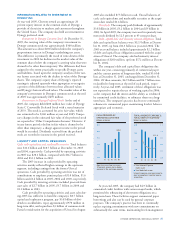Chevron 2005 Annual Report Download - page 33
Download and view the complete annual report
Please find page 33 of the 2005 Chevron annual report below. You can navigate through the pages in the report by either clicking on the pages listed below, or by using the keyword search tool below to find specific information within the annual report.
CHEVRON CORPORATION 2005 ANNUAL REPORT 31
Downstream
United States The company initiated a project to increase
the capacity of the Pascagoula, Mississippi, refi nery’s fl uid
catalytic cracking unit by approximately 25 percent, from
a current capacity of 63,000 barrels per day. This project is
designed to enable the refi nery to increase its production of
gasoline and other light products and is expected to be com-
pleted by late 2006.
South Korea The company’s 50 percent-owned GS
Caltex affi liate announced a major upgrade project at its
650,000-barrel-per-day Yeosu refi ning complex. At an esti-
mated total cost of $1.5 billion, the facilities will increase
the yield of high-value refi ned products and reduce feedstock
costs through the processing of heavy crude oil. Start-up is
expected by the end of 2007.
Chemicals
Qatar The company’s 50 percent-owned affi liate, Chevron
Phillips Chemical Company LLC (CPChem), has obtained
approvals and completed the fi nancial closing for the Q-Chem
II complex to be located next to the existing Q-Chem I com-
plex in Mesaieed, Qatar. The Q-Chem II complex will
include a 350,000-metric-ton-per-year polyethylene plant
and a 345,000-metric-ton-per-year normal alpha olefi ns
plant. The project also includes a separate joint venture to
develop a 1,300,000-metric-ton-per-year ethylene cracker at
Qatar’s Ras Laffan Industrial City. CPChem and its partners
expect to start-up the cracker and derivatives plants in late
2008. CPChem owns a 49 percent interest of Q-Chem II.
Other
Common Stock Dividends and Stock Repurchase Program In
April 2005, the company increased its quarterly common
stock dividend by 12.5 percent to $0.45 per share. The com-
pany completed an authorized $5 billion of stock buybacks
in November 2005 under a repurchase program initiated in
April 2004. Upon completion of this program, the company
then authorized the acquisition of up to $5 billion of addi-
tional shares over a period of up to three years. Purchases
under this authorization totaled $481 million through mid-
February 2006.
RESULTS OF OPERATIONS
Major Operating Areas The following section presents the
results of operations for the company’s business segments
– upstream, downstream and chemicals – as well as for “all
other,” which includes mining operations of coal and other
minerals, power generation businesses, and the various com-
panies and departments that are managed at the corporate
level. Income is also presented for the U.S. and international
geographic areas of the upstream and downstream business
segments. (Refer to Note 8, beginning on page 64, for a dis-
cussion of the company’s “reportable segments,” as defi ned
in FAS 131, “Disclosures About Segments of an Enterprise and
Related Information.”)
To aid in the understanding of changes in income
between periods, the discussion, when applicable, is in two
parts – fi rst on underlying trends, and second on special-
item gains and charges. The special items are identifi ed
separately because of their nature and amount and also to
help discern the underlying trends for the company’s busi-
nesses. This section should also be read in conjunction with
the discussion in “Business Environment and Outlook” on
pages 26 through 29.
U.S. Upstream – Exploration and Production
Millions of dollars 2005 2004 2003
Income From Continuing Operations $ 4,168 $ 3,868 $ 3,160
Income From Discontinued Operations – 70 23
Cumulative Effect of Accounting
Change – – (350)
Total Income* $ 4,168 $ 3,938 $ 2,833
*Includes Special-Item Gains (Charges):
Asset Dispositions
Continuing Operations $ – $ 316 $ 77
Discontinued Operations – 50 –
Litigation Provisions – (55) –
Asset Impairments/Write-offs – – (103)
Restructuring and Reorganizations – – (38)
Total $ – $ 311 $ (64)
U.S. upstream income of nearly $4.2 billion in 2005
increased $230 million. The amount in 2004 included net
special-item benefi ts (discussed below) of more than $300
million. Higher prices for crude oil and natural gas in 2005
and earnings from the former Unocal operations contributed
approximately $2 billion to the increase between periods.
Approximately 90 percent of this amount related to the
effects of higher prices on heritage-Chevron production.
These benefi ts were partially offset by the adverse effects
of lower production (discussed below), higher operating
expenses and higher depreciation expense associated with
heritage-Chevron properties.
Income of $3.9 billion in 2004 was $1.1 billion higher
than the $2.8 billion recorded in 2003. Of this increase,
$725 million resulted from the difference in the effect on
earnings in the respective periods from special items and the
cumulative-effect charges recorded in 2003 for the imple-
mentation of a new accounting standard. (Refer to Note 24,
beginning on page 83, for a discussion of FAS 143, “Account-
ing for Asset Retirement Obligations.”) The balance of the
increase from 2003 to 2004 was composed of about a $1 bil-
lion benefi t from higher prices for crude oil and natural gas
that was partially offset by the effect of lower production.
The company’s average realization for crude oil and natu-
ral gas liquids in 2005 was $46.97 per barrel, compared with
$34.12 in 2004 and $26.66 in 2003. The average natural gas
realization was $7.43 per thousand cubic feet in 2005, com-
pared with $5.51 and $5.01 in 2004 and 2003, respectively.
Net oil-equivalent production in 2005 averaged 727,000
barrels per day, down 11 percent from 2004 and 22 percent
from 2003. The decline between 2004 and 2005 was the
result of the effects of hurricanes, property sales and normal
fi eld declines, which were partially offset by the benefi t of
fi ve months of production in 2005 from properties acquired
from Unocal. The lower production between 2003 and 2004
























